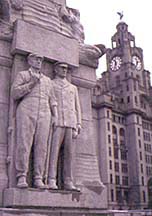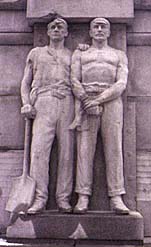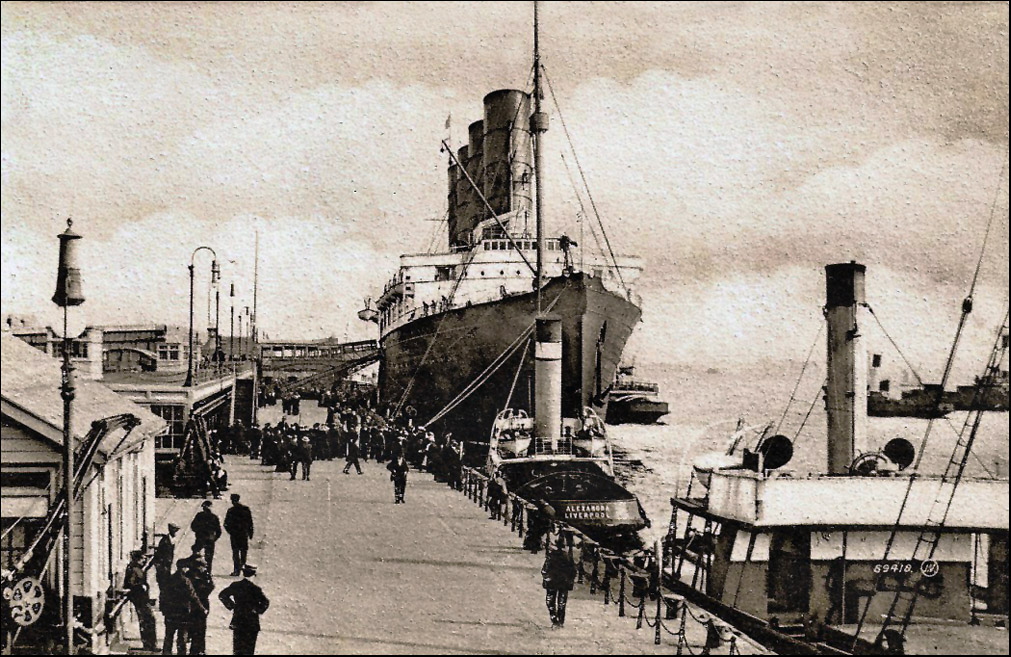|
"Many of your readers will have seen
the blockbuster film and may even have half-watched on TV the hocus-pocus
movie Raise the Titanic and may be interested in some true
facts about the sinking of the Titanic approaching midnight
on Sunday, 14th April, 1912...
The ship was owned by the International Merchant Marine Company (I.M.M.)
and flagged as the White Star Line which was founded in Britain in
1845. The I.M.M was an American and German organisation and its principal
player was the American J. Pierpont Morgan, a financier, who had created
'trusts' or cartels that eliminated competition in the American road
and rail systems (and this was subsequently acted upon by legislation
named the Patman Acts). White Star was founded by Thomas Henry Ismay, a grand old man who
had the misfortune to sire a weak fobbish son named Bruce Ismay who
got involved in share manipulation because White Star was financially
'on the rocks'.
It is sufficient to say that I.M.M bought White Star as a means of
removing Cunard (a wholly owned British company that was backed by
the British government with low fixed interest loans) from the supremacy
of holding the Blue Riband which was the transatlantic speed record
held by Cunard for over 20 years.
 The
Titanic was build at the Harland and Wolff shipyard in Belfast
and the chairman of this company was William James Pirrie who was
also a director of White Star and the International Merchant Marine
Co. Whilst the shipbuilding specification at Cunard was closely monitored
and indeed specified by the Admiralty, Harland and Wolff used a design
specification for building the Titanic that was a major factor
in the disaster. Cunard built ships that were of battleship design
as far as watertight subdivision is concerned and the Mauretania
also had a high sheer- or lift- to her bows and when she steamed into
heavy seas the water was thrown aside. The
Titanic was build at the Harland and Wolff shipyard in Belfast
and the chairman of this company was William James Pirrie who was
also a director of White Star and the International Merchant Marine
Co. Whilst the shipbuilding specification at Cunard was closely monitored
and indeed specified by the Admiralty, Harland and Wolff used a design
specification for building the Titanic that was a major factor
in the disaster. Cunard built ships that were of battleship design
as far as watertight subdivision is concerned and the Mauretania
also had a high sheer- or lift- to her bows and when she steamed into
heavy seas the water was thrown aside.
The Titanic had a more or less level forecastle and as she
steamed fast she tended to dig her bow into the water and the waves
broke over the forecastle making her wet and heavy to steer and slow
to turn.
Left and below: The crew are commemorated
on the Titianic Memorial on Liverpool Pier Head. Another photograph of it is here...
On the night in question however, the sea was a flat calm and the
shape of the bow was unimportant so we have to look at watertight
subdivision of the hull. The Mauretania, holder of the Blue
Riband for 27 years, was built along these lines- upper deck, main
deck, middle deck, lower deck, upper platform deck and below this
deck would be the fresh water tanks, boiler rooms, engine rooms, etc.
Below these functionary compartments is the lower platforms deck which
is also known as the keel platform deck. This had space underneath
following the curvature of the bottom of the ship and it is crawling
space. It is subdivided across the beam of the vessel and has access
hatches to each section. The upper platform deck and lower deck were
vertically subdivided with full height bulkheads or walls and access
to each division would be through bulkhead doors. Access to the upper
platform deck was restricted to operators and you had to sign in and
out to confirm that you had clamped all the doors shut that you had
opened. Each door had a dwarf bulkhead across the bottom three feet
high and five or six clamps or clips around the sides.
The Lusitania, the Mauretania and the Aquitania
were all built to these very high standards and they were all double
bottomed with riveted and welded amour-type plate and longitudinal
bracing girders and stretchers along the whole length of the ship
with the double bottom reaching up as far as the upper platform deck.
All engine room personnel would have had extra time to evacuate in
the event of emergency and of course the double strength in the bottom
and sides of the ship gave extra protection to all who sailed in them.
 The
Titanic was not built to these strict specifications for the
ship did not have any separation such as I have described on the lower
deck and upper platform deck or that part of the body of the ship
below and immediately above the plimsoll line- the mark which shows
how deeply she may be loaded. The Titanic was not subdivided
in these vulnerable areas with great walls of steel from top to bottom,
welded and riveted to deck stretchers and with escape bulkhead doors
which incorporated dwarf bulkheads across the bottom opening, but
was subdivided along its length with dwarf bulkheads which did not
reach up to the deck head- in fact they varied in height up to six
feet. In the event, water and ice could spill over from one section
to another and lead to the ships destruction. The
Titanic was not built to these strict specifications for the
ship did not have any separation such as I have described on the lower
deck and upper platform deck or that part of the body of the ship
below and immediately above the plimsoll line- the mark which shows
how deeply she may be loaded. The Titanic was not subdivided
in these vulnerable areas with great walls of steel from top to bottom,
welded and riveted to deck stretchers and with escape bulkhead doors
which incorporated dwarf bulkheads across the bottom opening, but
was subdivided along its length with dwarf bulkheads which did not
reach up to the deck head- in fact they varied in height up to six
feet. In the event, water and ice could spill over from one section
to another and lead to the ships destruction.
The Titanic was not double hulled and the water and ice could
not be contained within the inner and outer damage control area between
the two hulls. The Cunard liners were built for sailing in northern
latitudes where ice warnings were not unusual. The Titanic
appears to have been built for warmer cruising areas and had a higher
risk factor in her construction if used in northern latitudes.
To compound the issue the ship's master- Captain E. J. Smith-
had over his long career gathered a shocking record of accidents and
he was regarded by many master mariners as a person who was "reckless,
foolish" but above all, "heedless of danger". I would say he was indifferent with a low degree of excellence- he
had received six warnings of ice in the area and later he received
two further warnings from cargo ships, one from a cargo ship coming
on a reciprocal course towards Titanic:
"Have just passed through heavy field ice and several icebergs" and
"we are stopped and surrounded by ice. Exercise utmost caution."
The Titanic pressed on into the ice fields at 22 knots and
in the icy weather the lookouts (one of whom survived) were denied
binoculars because no one would force the lock on the cupboard in
which they were kept. (the officer holding the key had transferred
to the Olympic just before sailing.) These binoculars proved to be
the final part of this tragedy for if the lookout men had been issued
with them their eyes would have been protected and the magnification
would have allowed them to have seen the iceberg in time to save the
ship.
Had the Titanic been constructed in the same manner as the
Mauretania she would not have sunk. We know that the Titanic
filled up slowly as a result of damage to the side of the ship and
that she gradually went down by the head. In the Mauretania
the damaged sections could have been isolated and counter trim flooding
introduced until pumping got things under control.
The newspapers of that time chose to deal with other matters and some
tried to shift the blame on to Captain Walter Lord of the California.
The evidence in the official reports lay largely unquoted- but nevertheless
the report continues to exist.
Most people of the time believed the Titanic to be British
but in fact she was not and far from crushing Cunard the standard
bearer of Britain on the Atlantic run and holders of the Blue Riband.
'Morgan's monsters', the Olympic and the Britannic,
faded into the background and the Titanic is remembered for
the anguish it caused".
Old Wavertonian
|



 The
Titanic was build at the Harland and Wolff shipyard in Belfast
and the chairman of this company was William James Pirrie who was
also a director of White Star and the International Merchant Marine
Co. Whilst the shipbuilding specification at Cunard was closely monitored
and indeed specified by the Admiralty, Harland and Wolff used a design
specification for building the Titanic that was a major factor
in the disaster. Cunard built ships that were of battleship design
as far as watertight subdivision is concerned and the Mauretania
also had a high sheer- or lift- to her bows and when she steamed into
heavy seas the water was thrown aside.
The
Titanic was build at the Harland and Wolff shipyard in Belfast
and the chairman of this company was William James Pirrie who was
also a director of White Star and the International Merchant Marine
Co. Whilst the shipbuilding specification at Cunard was closely monitored
and indeed specified by the Admiralty, Harland and Wolff used a design
specification for building the Titanic that was a major factor
in the disaster. Cunard built ships that were of battleship design
as far as watertight subdivision is concerned and the Mauretania
also had a high sheer- or lift- to her bows and when she steamed into
heavy seas the water was thrown aside.  The
Titanic was not built to these strict specifications for the
ship did not have any separation such as I have described on the lower
deck and upper platform deck or that part of the body of the ship
below and immediately above the plimsoll line- the mark which shows
how deeply she may be loaded. The Titanic was not subdivided
in these vulnerable areas with great walls of steel from top to bottom,
welded and riveted to deck stretchers and with escape bulkhead doors
which incorporated dwarf bulkheads across the bottom opening, but
was subdivided along its length with dwarf bulkheads which did not
reach up to the deck head- in fact they varied in height up to six
feet. In the event, water and ice could spill over from one section
to another and lead to the ships destruction.
The
Titanic was not built to these strict specifications for the
ship did not have any separation such as I have described on the lower
deck and upper platform deck or that part of the body of the ship
below and immediately above the plimsoll line- the mark which shows
how deeply she may be loaded. The Titanic was not subdivided
in these vulnerable areas with great walls of steel from top to bottom,
welded and riveted to deck stretchers and with escape bulkhead doors
which incorporated dwarf bulkheads across the bottom opening, but
was subdivided along its length with dwarf bulkheads which did not
reach up to the deck head- in fact they varied in height up to six
feet. In the event, water and ice could spill over from one section
to another and lead to the ships destruction.